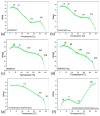Investigations on Thermal Transitions in PDPP4T/PCPDTBT/AuNPs Composite Films Using Variable Temperature Ellipsometry
- PMID: 40076196
- PMCID: PMC11902429
- DOI: 10.3390/polym17050704
Investigations on Thermal Transitions in PDPP4T/PCPDTBT/AuNPs Composite Films Using Variable Temperature Ellipsometry
Abstract
Herein, we report a comprehensive investigation on the thermal transitions of thin films of poly [2,5-bis(2-octyldodecyl)pyrrolo[3,4-c]pyrrole-1,4(2H,5H)-dione -3,6-diyl)-alt-(2,2';5',2″;5″,2'″-quaterthiophen-5,5'″-diyl)]PDPP4T, poly[2,6-(4,4-bis-(2-ethy-lhexyl)-4H-cyclopenta [2,1-b;3,4-b']dithiophene)-alt-4,7(2,1,3-benzothiadiazole)] PCPDTBT, 1:1 blend of PDPP4T and PCPDTBT, and their composites with gold nanoparticles (AuNPs). The thermal transitions of these materials were studied using variable temperature spectroscopic ellipsometry (VTSE), with differential scanning calorimetry (DSC) serving as the reference method. Based on obtained VTSE results, for the first time, we have determined the phase diagrams of PDPP4T/PCPDTBT and their AuNPs composites. The VTSE measurements revealed distinct thermal transitions in the thin films, including characteristic temperatures corresponding to the pure phases of PDPP4T and PCPDTBT within their blends. These transitions were markedly different in the AuNPs composites compared to the neat materials, highlighting the unique interactions between the polymer matrix and AuNPs. Additionally, we explored the optical properties, surface morphology, and crystallinity of the materials. We hypothesize that the observed variations in thermal transitions, as well as the improvement in optical properties and crystallinity, are likely influenced by localized surface plasmon resonance (LSPR) and passivation phenomena induced by the AuNPs in the composite films. These findings could have important implications for the design and optimization of materials for optoelectronic applications.
Keywords: polymer/nanoparticle composites; thermal transitions; thin films; variable temperature ellipsometry.
Conflict of interest statement
The authors declare no conflict of interest.
Figures











Similar articles
-
An Investigation of the Thermal Transitions and Physical Properties of Semiconducting PDPP4T:PDBPyBT Blend Films.Materials (Basel). 2022 Nov 25;15(23):8392. doi: 10.3390/ma15238392. Materials (Basel). 2022. PMID: 36499890 Free PMC article.
-
Polymeric Semiconductor in Field-Effect Transistors Utilizing Flexible and High-Surface Area Expanded Poly(tetrafluoroethylene) Membrane Gate Dielectrics.ACS Appl Mater Interfaces. 2024 Mar 13;16(10):12873-12885. doi: 10.1021/acsami.3c18777. Epub 2024 Mar 4. ACS Appl Mater Interfaces. 2024. PMID: 38437591
-
Phase Behavior of Amorphous/Semicrystalline Conjugated Polymer Blends.Polymers (Basel). 2020 Jul 31;12(8):1726. doi: 10.3390/polym12081726. Polymers (Basel). 2020. PMID: 32751981 Free PMC article.
-
Photodegradation of C-PCPDTBT and Si-PCPDTBT: influence of the bridging atom on the stability of a low-band-gap polymer for solar cell application.Chemphyschem. 2015 Feb 2;16(2):428-35. doi: 10.1002/cphc.201402494. Epub 2014 Nov 10. Chemphyschem. 2015. PMID: 25384350
-
Thermal Transitions and Structural Characteristics of Poly(3,4-ethylenedioxythiophene/cucurbit[7]uril) Polypseudorotaxane and Polyrotaxane Thin Films.Materials (Basel). 2024 Mar 13;17(6):1318. doi: 10.3390/ma17061318. Materials (Basel). 2024. PMID: 38541472 Free PMC article.
References
-
- Sulaiman A.K., Yap C.C., Touati F. Binary blend based dye sensitized photo sensor using PCPDTBT and MEH-PPV composite as a light sensitizer. Synth. Met. 2015;210:392–397. doi: 10.1016/j.synthmet.2015.11.005. - DOI
-
- Li Y., Wei Y., Feng K., Hao Y., Pei J., Zhang Y., Sun B. Introduction of PCPDTBT in P3HT:Spiro-OMeTAD blending system for solid-state hybrid solar cells with dendritic TiO2/Sb2S3 nanorods composite film. J. Sol. St. Chem. 2019;276:278–284. doi: 10.1016/j.jssc.2019.05.020. - DOI
-
- Nayak D., Choudhary R.B. A survey of the structure, fabrication, and characterization of advanced organic light emitting diodes. Microelectron. Reliab. 2023;144:114959. doi: 10.1016/j.microrel.2023.114959. - DOI
-
- Luo L., Liu Z. Recent progress in organic field-effect transistor-based chem/bio-sensors. View. 2022;3:20200115. doi: 10.1002/VIW.20200115. - DOI
LinkOut - more resources
Full Text Sources
Miscellaneous

